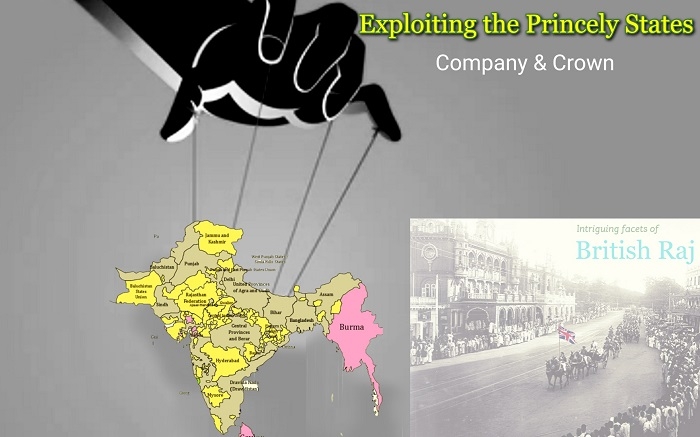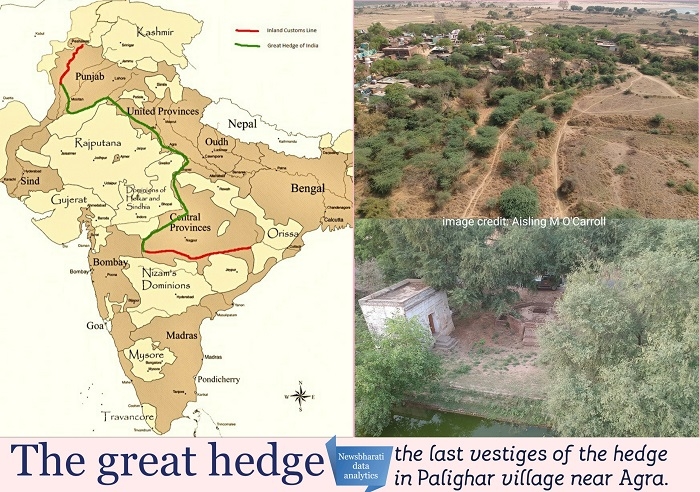Exploiting the Princely States: The company and the crown
The methods change, exploitation remains
Total Views |

There were two distinct stages in the empires relation with the Princely States. The first stage involved ad-hoc and hesitant measures to expand the empire. A collection of the treaties made and Sanads issued by the company and later by the British government runs into 14 volumes. But the common underlying factor for the company was always how much area it can digest and how much profit can be extracted from the area beyond the companies capacity of direct aquisition. One illustrative case is of the creation of Jammu and Kashmir State.
The creation of Jammu and Kashmir State
According to the treaty after the defeat in 1846 war, the Sikh kingdom had to forfeit a large area to the east India company and had to pay Rs. 1 Crore as war expenses. This they were not in a position to pay and instead offered additional territory from the Beas river to the Indus including Kashmir and Jammu. This posed a peculiar problem before the company as it was not in a position to occupy more area and also wanted money. The solution arrived at is described in 'The memoranda on Indian States, 1935' .
"........But Lord Hardinge, Governor General, considered the occupation of the whole of this territory inadvisable, as it would so largely increase the extent of the British frontier, and the military establishment for guarding it, and create new and conflicting interests, while the districts in question, with the exception of the comparatively small valley of Kashmir, were for the most part unproductive and unlikely to pay the cost of occupation and management. On the other hand, the ceded tract comprised the whole of the hereditary possessions of Gulab Singh, who being naturally eager to obtain an indefeasible title to them, came forward and offered to pay the war indemnity if constituted independent ruler of Jammu and Kashmir. A separate treaty embodying this arrangement was concluded with Gulab Singh at Amritsar on the 16th March 1846."
Tributes, ceded lands and annual payments
All Princely States had to pay some amount as annual tribute to the company. For example the treaty of 1799 by which the Mysore State was restored to Wodiyars, has a clause that the Mysore State will pay an annual tribute of 7 lakh star pagodas to company. (pagoda was the prevalent currency in south India. One star pagoda was equivalent to 3.5 Rupees) In 1882 the total tribute received by the company was 7 lakh pounds. This itself is a significant amount, but it is just a tip of an iceberg. There were many other means by which company used to extract money from the Princely States.
For bigger and powerful States like Gwalior or Hyderabad, large areas were permanently ceded to company for the expenses of the companies army for the 'protection' of the State. By four separate treaties in 1803, 1817, 1844 and in 1860, Gwalior State was forced to cede a large fertile area of the State to the company. When Hyderabad Nizam could not pay the due amounts, the fertile area of Berar (current Vidarbha region of Maharashtra state) was ceded by him to the company. The company maintained its army in many States
The armies of Princely States and the british control
but it was at the expense of those States.
Those States who did not cede land, had to pay annual expenses for the maintenance of the British army in the State in addition to the annual tribute. For example the State of Kota had to pay 2 lakh Rupees per year for the maintenance of the Mina corps stationed at Deoli. This was in addition to the annual tribute of 2,34,720 Rupees payable according to the treaty.
The salt
Monopoly of the salt trade was a major source of income for the empire. It was guarded jealously. Contrary to the popular belief, production of rock salt and mineral salt was of considerable proportion to salt production on Sea shore. Numerous treaties with various States restrict the amount of salt they can produce every year to the level of bare minimum for internal consumption, and prohibit salt export. For example, the treaty with Datia State in 1879 restricts the amount of salt production to 16480 mounds per year and explicitly prohibits export of salt outside the State. Although the Salt tax has been highlighted as an example of British cruelty, right from the first session of Indian national Congress in 1885 to the famous Dandi march of Gandhiji in 1930, the revenue loss of Princely States has remained an entirely neglected subject. In fact 'the great hedge' or the inland customs line was almost explicitly built to control salt and opium trade between Princely States and British India. Developed from 1840 onwards, at it's peak, it was 2500 miles long and was guarded by 12000 security persons. Ironically enough, it was Allan Hume, one of the founders of Indian national Congress, who was a key person in developing the hedge. After British took possession of Sambhar lake near Jaipur in 1870 and Khwera salt mines near Rawalpindi in 1872 (currently in Pakistan) , two largest salt production centers in north India, the hedge was abandoned.

Although in recent years the credit of bringing the ' the great hedge of India' in limelight is given to Roy Moxham, it was explicitly mentioned by R. C. Dutt in his classic work 'India in the Victorian age; an economic history of India' published in 1904. He clearly mentions that the purpose was to control the trade of salt from Princely States.
".....the salt revenue is derived firstly from a duty imposed on the manufacture of salt in British India, and secondly, from a duty imposed on salt imported from Europe or from the Native States of India. The task of levying a duty on salt imported by sea was easy enough. But in order to realise the duty on salt imported from the Native States, it was necessary to maintain an Inland Customs Line. In 1870 this Indian Customs Line extended itself across the whole of British India, from a joint in the north-west of the Punjab to the northern frontiers of Madras. It was a huge material barrier, 2500 miles long, consisting of thorny trees and bushes, stone walls......"
He also mentioned how it was discontinued in 1879
"The first steps towards abolishing this system were taken by the Government of Lord Mayo. Mr. A. O. Hume negotiated an amicable arrangement with the Native States of Jaipur and Jodhpur, under which the sole right of manufacturing salt at the Sambar Salt Lake was made over to the Indian Government. The Government of Lord Northbrook then entered into an arrangement with Jodhpur, by which all important salt sources of that State were transferred to British management."

Considering the fact that at the end of Century in year 1899-1900, the British income from salt tax was 8 Crore 27 lakh Rupees, it is beyond imagination to estimate the loss of Princely States from restrictions on salt production over the entire period.
Opium
Less highlighted fact than salt trade is the monopoly of the opium trade, partly because the trade practically ended in 1918. Before that it was a large part of the empires income. For example the average income for the fourteen years ending in 1894 was five million sterling. Although the company enjoyed monopoly over the Bengal opium, it was only half of the total production. The other half, almost 50 % production was in the Princely States of Malwa region. As usual various treaties were made with the States to monopolize the opium trade. A typical treaty with Indore, provides clauses to restrict the opium production to six thousand maunds per year, of which a thousand might be retained for local consumption, the remainder to be delivered to the company's godowns in Indore or Mahidpur. Similar treaties were made with Kotah, Bundi, Dhar, and Dewas. In a treaty with Mewar State in 1824, the maharana agreed to prohibit the sale and transit of any opium other than that authorized by the British government. Unlicensed opium was to be confiscated and delivered to the agent at the current price in Malwa, one-half of the value to be paid to the informer.
It is obvious but has often gone unnoticed that such treaties incurred a great loss to the revenue of the States and benefitted the company immensely. The importance of revenue from monopoly on salt and opium trade can be seen from the following graph comparing proportion of major income sources of the British India in year 1903.
Gold
With negotiated amicable arrangements, the precious metals and minerals, whenever they were found in Princely States, were controlled by British. The famous Kolar gold mines of Mysore is an example. The memoranda on Princely States published in 1935 mentions how the State funds were used to generate electricity for the benefit of a British company.
"The State is now the principal gold producing centre in India, the value of the output, including that of a relatively small quantity of silver, for 1933 being £ 2,086,002. The source of the metal at present is the Kolar Gold Fields, situated to the east of a low ridge in the Bowringpet taluk. The industry is wholly British, the bulk of it being under the management of the firm of Messrs. John Taylor and Sons. With a view to reduce the working expenses of the mines the Darbar have adopted a bold scheme for utilizing the water-power of Falls of the Cauvery at Sivasamndram for the generation of electricity and for the transmission of that power to the Gold Fields...."
After 1858
The measures of east india company were crude. Once the British crown assumed direct power, all the previous measures to drain the wealth of Princely States continued. In addition, sofisticated but more deadly measures were introduced. One consistent pressure on the Princely States after the crown took over was to abandon their separate currency and accept the British rupee as currency. With some persuasion, all States were made to accept this over the next few decades. For example, by the treaty in year 1904 the Maharaja of Datia was made to cease coining Raja Shahi Rupees, which was the currency of Datia State. How the Rupee and pound exchange rate was artificially maintained by the British to drain wealth from India has been shown by Dr. Ambedkar in his Doctoral thesis at the London School of Economics, 'The problem of Rupee'.
But along with monetary and material gains, the velvet grip of the crown was used to gain access to the most valuable resource, the human resources of India. The armies of the Princely States were developed in to a subsidiary force to fight the empires battles all over the world. How they did it is the topic of our upcoming article.

